RENAULT KOLEOS 2012 1.G Owners Manual
Manufacturer: RENAULT, Model Year: 2012, Model line: KOLEOS, Model: RENAULT KOLEOS 2012 1.GPages: 233, PDF Size: 7.81 MB
Page 91 of 233
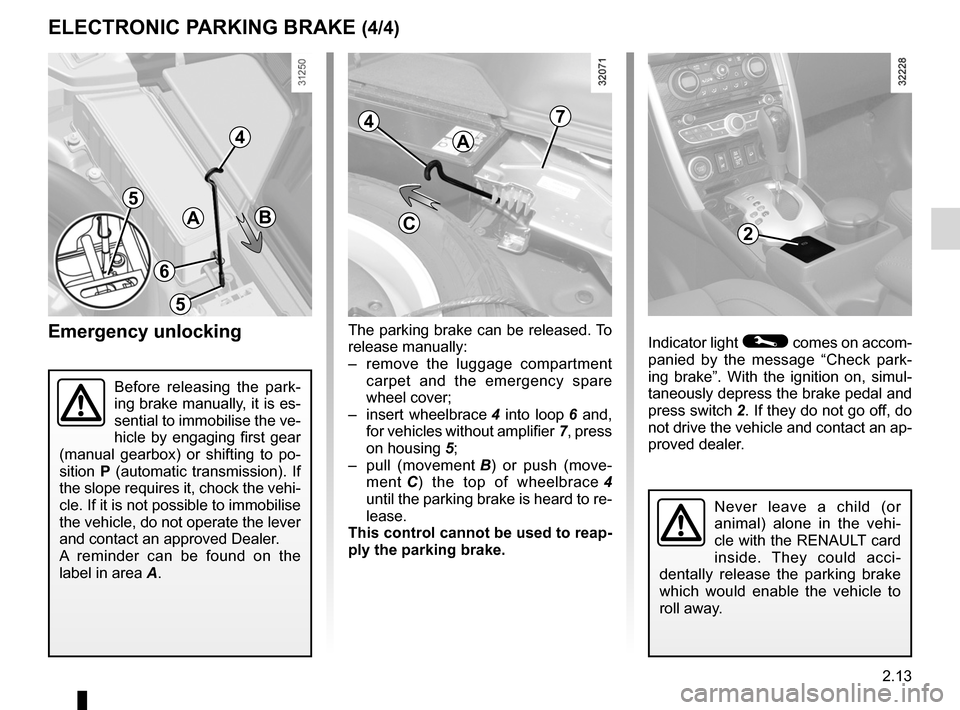
JauneNoirNoir texte
2.13
ENG_UD27280_8
Frein de parking assist (X45 - H45 - Renault)
ENG_NU_977-2_H45_Ph2_Renault_2
ELECTRONIC PARKING BRAKE (4/4)
Indicator light © comes on accom-
panied by the message “ Check park-
ing brake ”. With the ignition on, simul -
taneously depress the brake pedal and
press switch 2. If they do not go off, do
not drive the vehicle and contact an ap-
proved dealer.
2
Never leave a child (or
animal) alone in the vehi -
cle with the RENAULT card
inside. They could acci -
dentally release the parking brake
which would enable the vehicle to
roll away.
The parking brake can be released. To
release manually:
– remove the luggage compartment
carpet and the emergency spare
wheel cover;
– insert wheelbrace 4 into loop 6 and,
for vehicles without amplifier 7, press
on housing 5;
– pull (movement B ) or push (move -
ment C ) the top of wheelbrace 4
until the parking brake is heard to re-
lease.
This control cannot be used to reap-
ply the parking brake.
Before releasing the park -
ing brake manually, it is es-
sential to immobilise the ve-
hicle by engaging first gear
(manual gearbox) or shifting to po -
sition P (automatic transmission). If
the slope requires it, chock the vehi-
cle. If it is not possible to immobilise
the vehicle, do not operate the lever
and contact an approved Dealer.
A reminder can be found on the
label in area A.
A
4
6
5
5
Emergency unlocking
B
4
A
7
C
Page 92 of 233
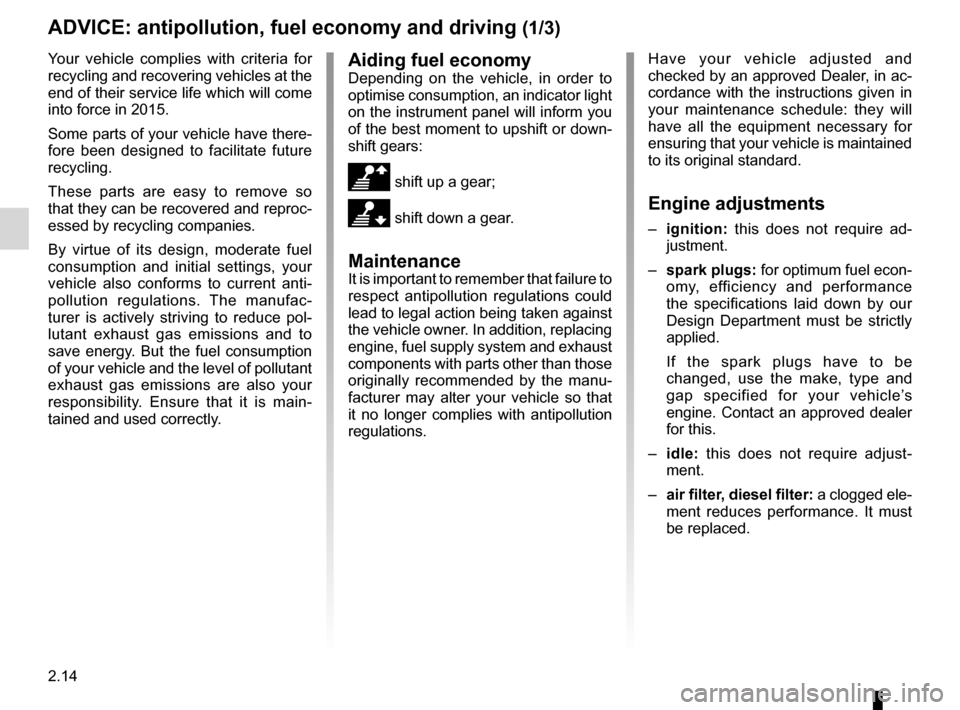
driving ................................................... (up to the end of the DU)
fuel economy ........................................ (up to the end of the DU)
advice on antipollution .......................... (up to the end of the DU)
antipollution advice .............................................................. (current page)
fuel advice on fuel economy ................................... (current page)
2.14
ENG_UD27288_2
Conseils : antipollution, conomies de carburant, conduite (X45 - H45 - Renault)
ENG_NU_977-2_H45_Ph2_Renault_2
Jaune NoirNoir texte
Advice: antipollution and fuel economy
ADvICE: antipollution, fuel economy and driving (1/3)
Your vehicle complies with criteria for
recycling and recovering vehicles at the
end of their service life which will come
into force in 2015.
Some parts of your vehicle have there-
fore been designed to facilitate future
recycling.
These parts are easy to remove so
that they can be recovered and reproc-
essed by recycling companies.
By virtue of its design, moderate fuel
consumption and initial settings, your
vehicle also conforms to current anti-
pollution regulations. The manufac -
turer is actively striving to reduce pol -
lutant exhaust gas emissions and to
save energy. But the fuel consumption
of your vehicle and the level of pollutant
exhaust gas emissions are also your
responsibility. Ensure that it is main -
tained and used correctly.Aiding fuel economyDepending on the vehicle, in order to
optimise consumption, an indicator light
on the instrument panel will inform you
of the best moment to upshift or down -
shift gears:
\ shift up a gear;
[ shift down a gear.
MaintenanceIt is important to remember that failure to
respect antipollution regulations could
lead to legal action being taken against
the vehicle owner. In addition, replacing
engine, fuel supply system and exhaust
components with parts other than those
originally recommended by the manu -
facturer may alter your vehicle so that
it no longer complies with antipollution
regulations. Have your vehicle adjusted and
checked by an approved Dealer, in ac-
cordance with the instructions given in
your maintenance schedule: they will
have all the equipment necessary for
ensuring that your vehicle is maintained
to its original standard.
Engine adjustments
–
ignition: this does not require ad -
justment.
– spark plugs: for optimum fuel econ-
omy, efficiency and performance
the specifications laid down by our
Design Department must be strictly
applied.
If the spark plugs have to be
changed, use the make, type and
gap specified for your vehicle’s
engine. Contact an approved dealer
for this.
– idle: this does not require adjust -
ment.
– air filter, diesel filter: a clogged ele-
ment reduces performance. It must
be replaced.
Page 93 of 233

JauneNoirNoir texte
2.15
ENG_UD27288_2
Conseils : antipollution, conomies de carburant, conduite (X45 - H45 - Renault)
ENG_NU_977-2_H45_Ph2_Renault_2
ADvICE: antipollution, fuel economy and driving (2/3)
– Sporty driving uses a lot of fuel: drive
with a light right foot.
– Brake as little as possible. If you an-
ticipate an obstacle or bend in ad -
vance, you may then simply release
the accelerator pedal.
– Do not try to maintain the same
speed up a hill, accelerate no more
than you would on the level. Keep
your foot in the same position on the
accelerator pedal.
– Double declutching and accelerating
before switching off are unnecessary
in modern vehicles.
– Bad weather, flooded roads:
Do not drive through floods
if the water is above the
lower edge of the wheel
rims.Driving– Drive carefully for the first few miles
until the engine reaches its normal
operating temperature, rather than
let it warm up while the vehicle is sta-
tionary.
– Speed is expensive.
– Do not overrev the engine in the in-
termediate gears.
Always use the highest gear possi -
ble without labouring the engine.
On versions with an automatic gear-
box, it is preferable to keep the gear
lever in position D.
– Avoid sudden acceleration.
Exhaust gas monitoring
system
The exhaust gas monitoring system will
detect any operating faults in the vehi-
cle’s antipollution system.
If this system malfunctions, toxic sub -
stances may be released into the at -
mosphere or damage may occur.
ÄThis warning light on the in -
strument panel will indicate if
there are any faults in the system:
This lights up when the ignition is
switched on and goes out when the
engine is started.
– If it lights up continuously, consult an
approved Dealer as soon as possi -
ble;
– if it flashes, reduce the engine speed
until the light stops flashing. Contact
your approved dealer as soon as
possible.
Obstructions to the driver
On the driver ’s side, only
use mats suitable for the
vehicle, attached with the
pre-fitted components, and check
the fitting regularly. Do not lay one
mat on top of another.
There is a risk of wedging the
pedals
Page 94 of 233
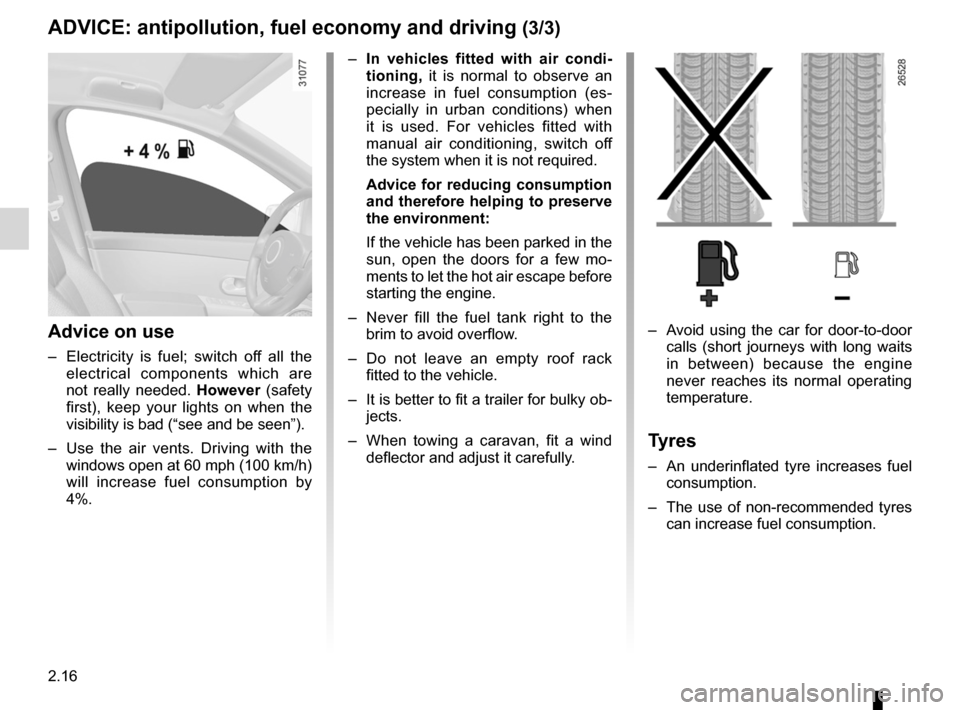
2.16
ENG_UD27288_2
Conseils : antipollution, conomies de carburant, conduite (X45 - H45 - Renault)
ENG_NU_977-2_H45_Ph2_Renault_2
ADvICE: antipollution, fuel economy and driving (3/3)
Advice on use
– Electricity is fuel; switch off all the
electrical components which are
not really needed. However (safety
first), keep your lights on when the
visibility is bad (“see and be seen”).
– Use the air vents. Driving with the
windows open at 60 mph (100 km/h)
will increase fuel consumption by
4%.
– Avoid using the car for door-to-door
calls (short journeys with long waits
in between) because the engine
never reaches its normal operating
temperature.
Tyres
– An underinflated tyre increases fuel
consumption.
– The use of non-recommended tyres
can increase fuel consumption.
–
In vehicles fitted with air condi -
tioning, it is normal to observe an
increase in fuel consumption (es -
pecially in urban conditions) when
it is used. For vehicles fitted with
manual air conditioning, switch off
the system when it is not required.
Advice for reducing consumption
and therefore helping to preserve
the environment:
If the vehicle has been parked in the
sun, open the doors for a few mo -
ments to let the hot air escape before
starting the engine.
– Never fill the fuel tank right to the
brim to avoid overflow.
– Do not leave an empty roof rack
fitted to the vehicle.
– It is better to fit a trailer for bulky ob-
jects.
– When towing a caravan, fit a wind
deflector and adjust it carefully.
Page 95 of 233
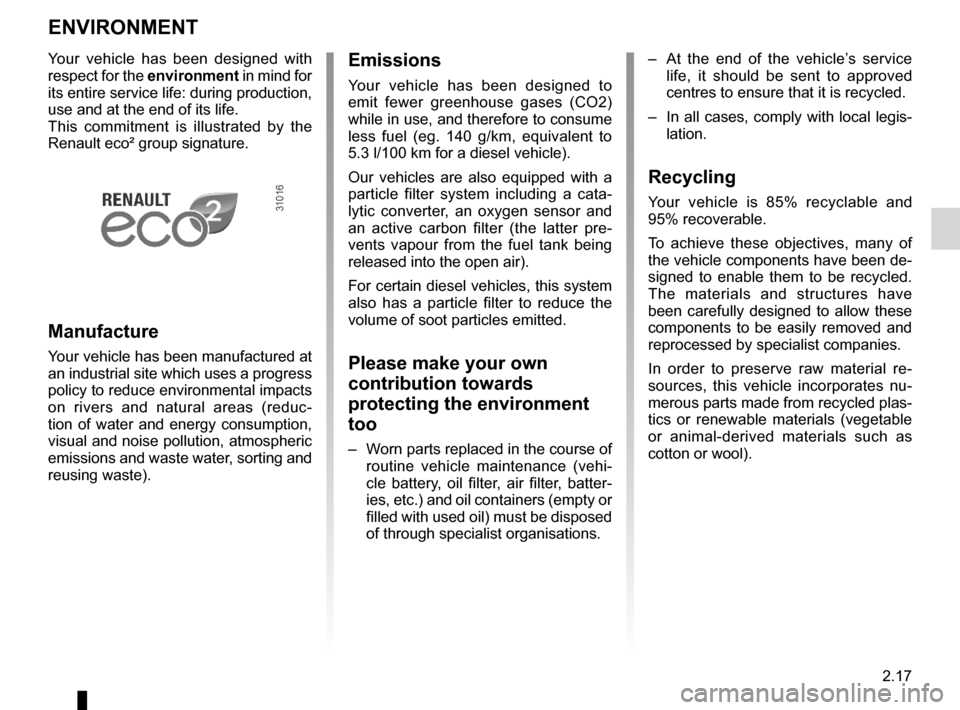
environment .......................................... (up to the end of the DU)
2.17
ENG_UD20974_4
Environnement (X35 - X44 - X45 - H45 - X65 - S65 - X77 - X81 - X85 - X91 - D91 - X76 - X83 - X61 - B65 - C65 - X77 ph2 - X95 - E95 - J95 - R95 - L38 - E33 - X33 - X38
ENG_NU_977-2_H45_Ph2_Renault_2
Environment
ENvIRONMENT
Emissions
Your vehicle has been designed to
emit fewer greenhouse gases (CO2)
while in use, and therefore to consume
less fuel (eg. 140 g/km, equivalent to
5.3 l/100 km for a diesel vehicle).
Our vehicles are also equipped with a
particle filter system including a cata -
lytic converter, an oxygen sensor and
an active carbon filter (the latter pre -
vents vapour from the fuel tank being
released into the open air).
For certain diesel vehicles, this system
also has a particle filter to reduce the
volume of soot particles emitted.
Please make your own
contribution towards
protecting the environment
too
– Worn parts replaced in the course of
routine vehicle maintenance (vehi -
cle battery, oil filter, air filter, batter -
ies, etc.) and oil containers (empty or
filled with used oil) must be disposed
of through specialist organisations. –
At the end of the vehicle’s service
life, it should be sent to approved
centres to ensure that it is recycled.
– In all cases, comply with local legis -
lation.
Recycling
Your vehicle is 85% recyclable and
95% recoverable.
To achieve these objectives, many of
the vehicle components have been de-
signed to enable them to be recycled.
The materials and structures have
been carefully designed to allow these
components to be easily removed and
reprocessed by specialist companies.
In order to preserve raw material re -
sources, this vehicle incorporates nu -
merous parts made from recycled plas-
tics or renewable materials (vegetable
or animal-derived materials such as
cotton or wool).
Your vehicle has been designed with
respect for the
environment in mind for
its entire service life: during production,
use and at the end of its life.
This commitment is illustrated by the
Renault eco² group signature.
Manufacture
Your vehicle has been manufactured at
an industrial site which uses a progress
policy to reduce environmental impacts
on rivers and natural areas (reduc -
tion of water and energy consumption,
visual and noise pollution, atmospheric
emissions and waste water, sorting and
reusing waste).
Page 96 of 233
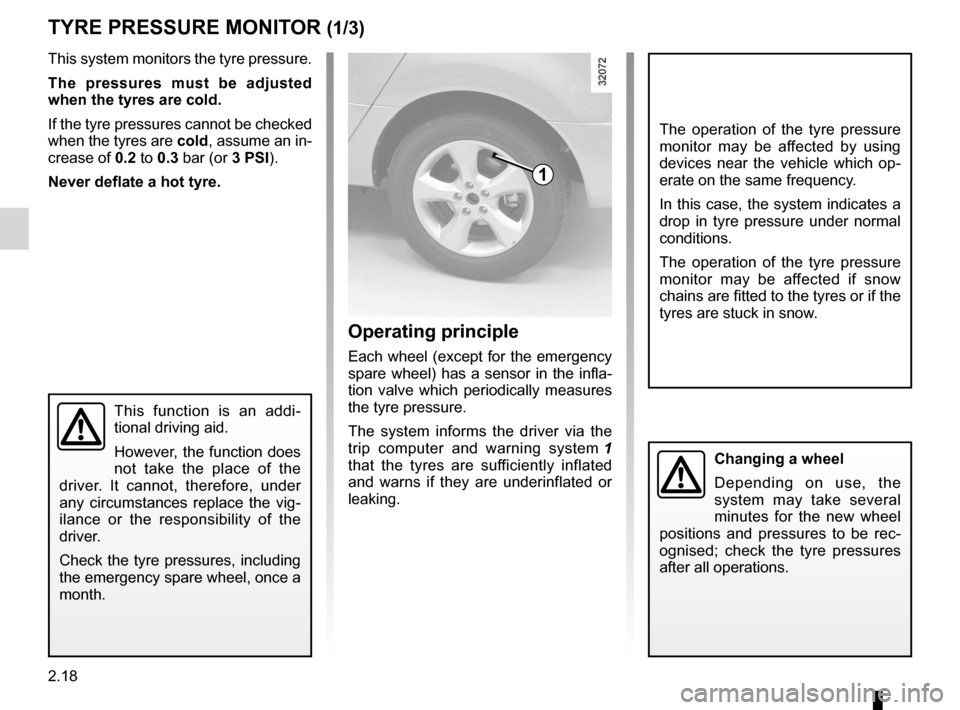
tyres ...................................................... (up to the end of the DU)
tyre pressure monitor ............................(up to the end of the DU)
tyre pressure ......................................... (up to the end of the DU)
driving ................................................... (up to the end of the DU)
2.18
ENG_UD27289_6
Syst me de surveillance de pression des pneumatiques (X45 - H45 - Renault)
ENG_NU_977-2_H45_Ph2_Renault_2
Jaune NoirNoir texte
Tyre pressure monitor
TYRE PRESSURE MONITOR (1/3)
This system monitors the tyre pressure.
The pressures must be adjusted
when the tyres are cold.
If the tyre pressures cannot be checked
when the tyres are cold, assume an in-
crease of 0.2 to 0.3 bar (or 3 PSI).
Never deflate a hot tyre.
Operating principle
Each wheel (except for the emergency
spare wheel) has a sensor in the infla-
tion valve which periodically measures
the tyre pressure.
The system informs the driver via the
trip computer and warning system 1
that the tyres are sufficiently inflated
and warns if they are underinflated or
leaking.
1
This function is an addi -
tional driving aid.
However, the function does
not take the place of the
driver. It cannot, therefore, under
any circumstances replace the vig -
ilance or the responsibility of the
driver.
Check the tyre pressures, including
the emergency spare wheel, once a
month.
The operation of the tyre pressure
monitor may be affected by using
devices near the vehicle which op -
erate on the same frequency.
In this case, the system indicates a
drop in tyre pressure under normal
conditions.
The operation of the tyre pressure
monitor may be affected if snow
chains are fitted to the tyres or if the
tyres are stuck in snow.
Changing a wheel
Depending on use, the
system may take several
minutes for the new wheel
positions and pressures to be rec -
ognised; check the tyre pressures
after all operations.
Page 97 of 233
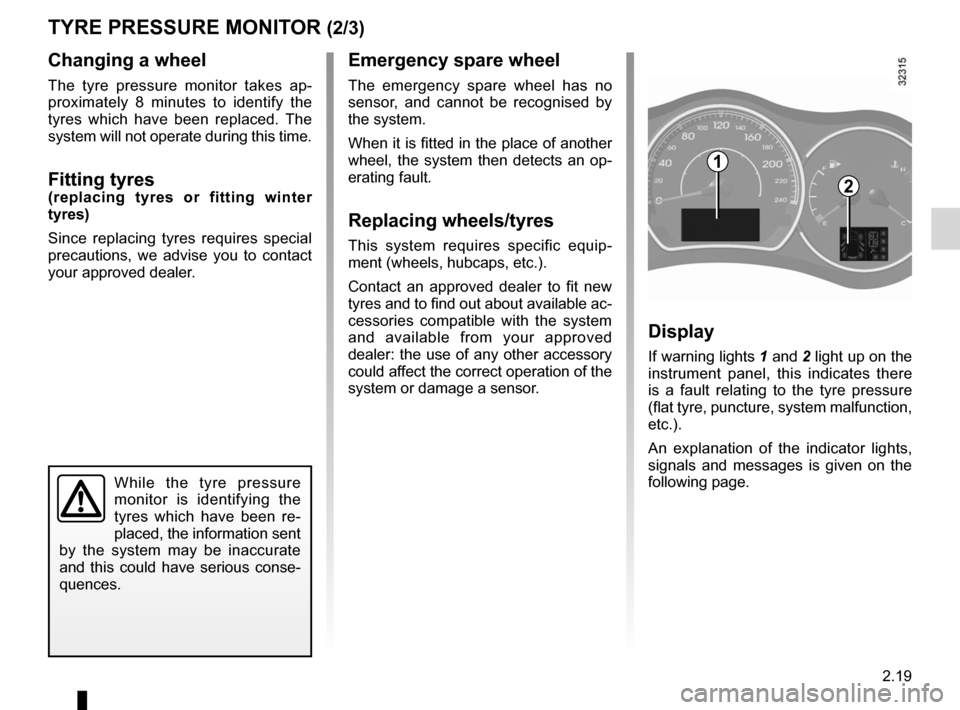
JauneNoirNoir texte
2.19
ENG_UD27289_6
Syst me de surveillance de pression des pneumatiques (X45 - H45 - Renault)
ENG_NU_977-2_H45_Ph2_Renault_2
TYRE PRESSURE MONITOR (2/3)
Changing a wheel
The tyre pressure monitor takes ap -
proximately 8 minutes to identify the
tyres which have been replaced. The
system will not operate during this time.
Fitting tyres(replacing tyres or fitting winter
tyres)
Since replacing tyres requires special
precautions, we advise you to contact
your approved dealer.
While the tyre pressure
monitor is identifying the
tyres which have been re -
placed, the information sent
by the system may be inaccurate
and this could have serious conse-
quences.
Emergency spare wheel
The emergency spare wheel has no
sensor, and cannot be recognised by
the system.
When it is fitted in the place of another
wheel, the system then detects an op-
erating fault.
Replacing wheels/tyres
This system requires specific equip -
ment (wheels, hubcaps, etc.).
Contact an approved dealer to fit new
tyres and to find out about available ac-
cessories compatible with the system
and available from your approved
dealer: the use of any other accessory
could affect the correct operation of the
system or damage a sensor.
Display
If warning lights 1 and 2 light up on the
instrument panel, this indicates there
is a fault relating to the tyre pressure
(flat tyre, puncture, system malfunction,
etc.).
An explanation of the indicator lights,
signals and messages is given on the
following page.
1
2
Page 98 of 233
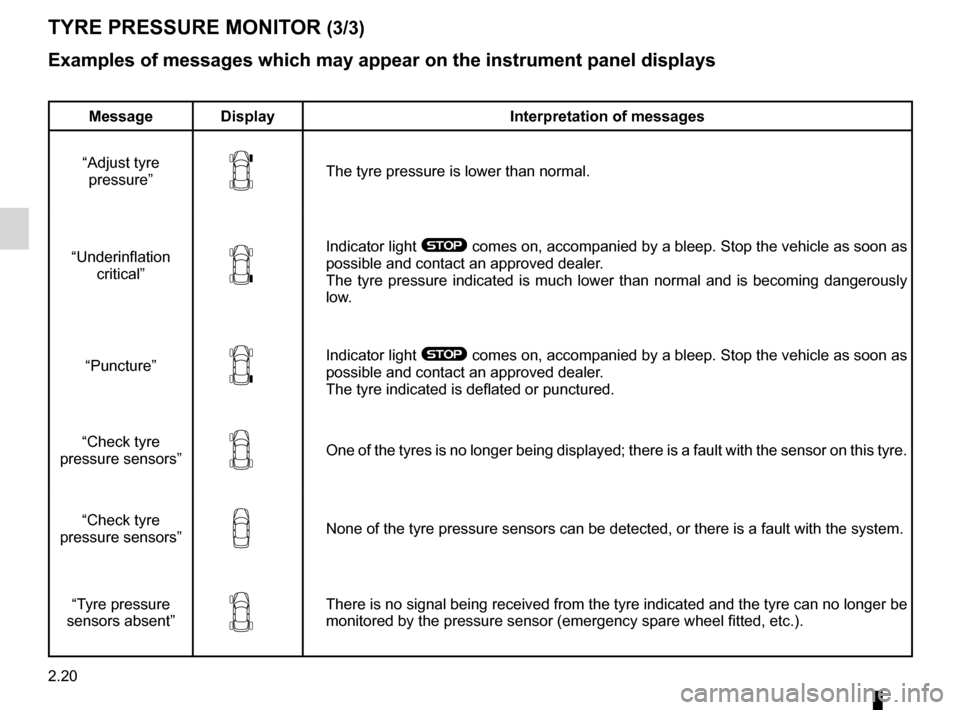
2.20
ENG_UD27289_6
Syst me de surveillance de pression des pneumatiques (X45 - H45 - Renault)
ENG_NU_977-2_H45_Ph2_Renault_2
TYRE PRESSURE MONITOR (3/3)
Examples of messages which may appear on the instrument panel displays
Message Display Interpretation of messages
“Adjust tyre pressure ”
The tyre pressure is lower than normal.
“Underinflation critical”
Indicator light ® comes on, accompanied by a bleep. Stop the vehicle as soon as
possible and contact an approved dealer.
The tyre pressure indicated is much lower than normal and is becoming dangerously
low.
“Puncture”
Indicator light ® comes on, accompanied by a bleep. Stop the vehicle as soon as
possible and contact an approved dealer.
The tyre indicated is deflated or punctured.
“Check tyre
pressure sensors ”
One of the tyres is no longer being displayed; there is a fault with the sensor on this tyre.
“Check tyre
pressure sensors ”
None of the tyre pressure sensors can be detected, or there is a fault with the system.
“Tyre pressure
sensors absent ”
There is no signal being received from the tyre indicated and the tyre can no longer be
monitored by the pressure sensor (emergency spare wheel fitted, etc.).
Page 99 of 233
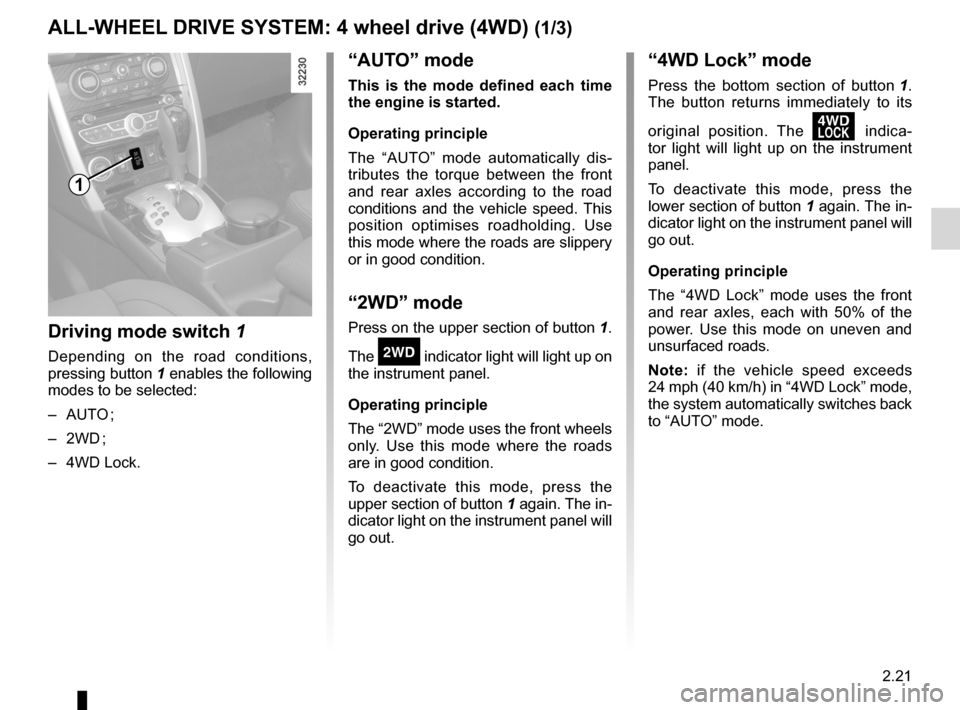
driving ................................................... (up to the end of the DU)
4 wheel drive (4WD) ............................. (up to the end of the DU)
all-wheel drive system .......................... (up to the end of the DU)
2.21
ENG_UD27290_7
Transmission int grale : 4 roues motrices : 4WD (X45 - H45 - Renault)
ENG_NU_977-2_H45_Ph2_Renault_2
All-wheel drive transmission: 4-wheel drive (4WD)
ALL-wHEEL DRIvE SYSTEM: 4 wheel drive (4wD) (1/3)
“AUTO” mode
This is the mode defined each time
the engine is started.
Operating principle
The “AUTO” mode automatically dis -
tributes the torque between the front
and rear axles according to the road
conditions and the vehicle speed. This
position optimises roadholding. Use
this mode where the roads are slippery
or in good condition.
“2wD” mode
Press on the upper section of button 1.
The
‘ indicator light will light up on
the instrument panel.
Operating principle
The “2WD” mode uses the front wheels
only. Use this mode where the roads
are in good condition.
To deactivate this mode, press the
upper section of button 1 again. The in-
dicator light on the instrument panel will
go out.
“4wD Lock” mode
Press the bottom section of button 1 .
The button returns immediately to its
original position. The
’ indica -
tor light will light up on the instrument
panel.
To deactivate this mode, press the
lower section of button 1 again. The in-
dicator light on the instrument panel will
go out.
Operating principle
The “4WD Lock” mode uses the front
and rear axles, each with 50% of the
power. Use this mode on uneven and
unsurfaced roads.
Note: if the vehicle speed exceeds
24 mph (40 km/h) in “4WD Lock” mode,
the system automatically switches back
to “AUTO” mode.
Driving mode switch 1
Depending on the road conditions,
pressing button 1 enables the following
modes to be selected:
– AUTO ;
– 2WD ;
– 4WD Lock.
1
Page 100 of 233
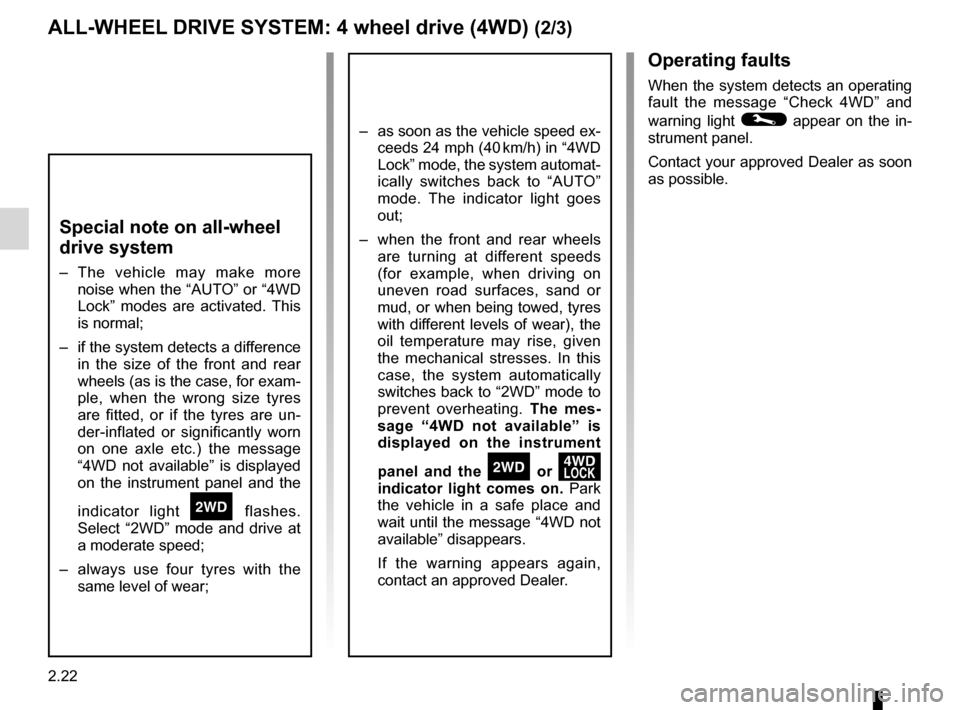
2.22
ENG_UD27290_7
Transmission int grale : 4 roues motrices : 4WD (X45 - H45 - Renault)
ENG_NU_977-2_H45_Ph2_Renault_2
Jaune NoirNoir texte
ALL-wHEEL DRIvE SYSTEM: 4 wheel drive (4wD) (2/3)
Special note on all-wheel
drive system
– The vehicle may make more
noise when the “AUTO” or “4WD
Lock” modes are activated. This
is normal;
– if the system detects a difference
in the size of the front and rear
wheels (as is the case, for exam-
ple, when the wrong size tyres
are fitted, or if the tyres are un -
der-inflated or significantly worn
on one axle etc.) the message
“4WD not available ” is displayed
on the instrument panel and the
indicator light
‘ flashes.
Select “2WD” mode and drive at
a moderate speed;
– always use four tyres with the
same level of wear;
– as soon as the vehicle speed ex-
ceeds 24 mph (40 km/h) in “4WD
Lock” mode, the system automat-
ically switches back to “AUTO”
mode. The indicator light goes
out;
– when the front and rear wheels
are turning at different speeds
(for example, when driving on
uneven road surfaces, sand or
mud, or when being towed, tyres
with different levels of wear), the
oil temperature may rise, given
the mechanical stresses. In this
case, the system automatically
switches back to “2WD” mode to
prevent overheating. The mes-
sage “ 4w D not available ” is
displayed on the instrument
panel and the
‘ or ’
indicator light comes on. Park
the vehicle in a safe place and
wait until the message “4WD not
available ” disappears.
If the warning appears again,
contact an approved Dealer.
Operating faults
When the system detects an operating
fault the message “ Check 4WD” and
warning light
© appear on the in-
strument panel.
Contact your approved Dealer as soon
as possible.